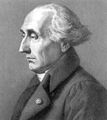Template:Selected anniversaries/April 9: Difference between revisions
No edit summary |
No edit summary |
||
| Line 1: | Line 1: | ||
<gallery> | <gallery> | ||
||1624 | ||1624: Henrik Rysensteen born ... military engineer. Pic. | ||
||Benedetto Castelli | ||1643: Benedetto Castelli dies ... mathematician. pic | ||
||Christian Wolff | ||1754: Christian Wolff dies ... philosopher. Wolff was the most eminent German philosopher between Leibniz and Kant. His main achievement was a complete oeuvre on almost every scholarly subject of his time, displayed and unfolded according to his demonstrative-deductive, mathematical method. Pic. | ||
File:Thomas Seebeck.jpg|link=Thomas Johann Seebeck (nonfiction)|1770: Physicist and academic [[Thomas Johann Seebeck (nonfiction)|Thomas Johann Seebeck]] born. He will discover the thermoelectric effect. | File:Thomas Seebeck.jpg|link=Thomas Johann Seebeck (nonfiction)|1770: Physicist and academic [[Thomas Johann Seebeck (nonfiction)|Thomas Johann Seebeck]] born. He will discover the thermoelectric effect. | ||
||George Peacock | ||1791: George Peacock born ... mathematician. | ||
File:Joseph-Louis Lagrange.jpg|link=Joseph-Louis Lagrange (nonfiction)|1805: Mathematician and crime-fighter [[Joseph-Louis Lagrange (nonfiction)|Joseph-Louis Lagrange]] delivers lecture on applications of number theory to the detection and prevention of [[crimes against mathematical constants]]. | File:Joseph-Louis Lagrange.jpg|link=Joseph-Louis Lagrange (nonfiction)|1805: Mathematician and crime-fighter [[Joseph-Louis Lagrange (nonfiction)|Joseph-Louis Lagrange]] delivers lecture on applications of number theory to the detection and prevention of [[crimes against mathematical constants]]. | ||
||Isambard Kingdom Brunel | ||1806: Isambard Kingdom Brunel born ... mechanical and civil engineer who is considered "one of the most ingenious and prolific figures in engineering history" | ||
||Edmond Nicolas Laguerre | ||1834: Edmond Nicolas Laguerre born ... mathematician, a member of the Académie française (1885). His main works were in the areas of geometry and complex analysis. He also investigated orthogonal polynomials (see Laguerre polynomials). Laguerre's method is a root-finding algorithm tailored to polynomials. | ||
||William Prout | ||1850: William Prout born ... chemist, physician, and natural theologian. He is remembered today mainly for what is called Prout's hypothesis. Pic. | ||
File:Edouard-Léon Scott de Martinville.jpg|link=Édouard-Léon Scott de Martinville (nonfiction)|1860: On his phonautograph machine, [[Édouard-Léon Scott de Martinville (nonfiction)|Édouard-Léon Scott de Martinville]] makes the oldest known recording of an audible human voice. A visual recording of audio data, it will first be played back in 2008. | File:Edouard-Léon Scott de Martinville.jpg|link=Édouard-Léon Scott de Martinville (nonfiction)|1860: On his phonautograph machine, [[Édouard-Léon Scott de Martinville (nonfiction)|Édouard-Léon Scott de Martinville]] makes the oldest known recording of an audible human voice. A visual recording of audio data, it will first be played back in 2008. | ||
| Line 26: | Line 25: | ||
File:Charles Proteus Steinmetz.jpg|link=Charles Proteus Steinmetz (nonfiction)|1865: Mathematician and electrical engineer [[Charles Proteus Steinmetz (nonfiction)|Charles Proteus Steinmetz]] born. He will foster the development of alternating current, formulating mathematical theories which will advance the expansion of the electric power industry in the United States. | File:Charles Proteus Steinmetz.jpg|link=Charles Proteus Steinmetz (nonfiction)|1865: Mathematician and electrical engineer [[Charles Proteus Steinmetz (nonfiction)|Charles Proteus Steinmetz]] born. He will foster the development of alternating current, formulating mathematical theories which will advance the expansion of the electric power industry in the United States. | ||
||André-Michel Guerry | ||1866: André-Michel Guerry dies ... lawyer and amateur statistician. Together with Adolphe Quetelet he may be regarded as the founder of moral statistics which led to the development of criminology, sociology and ultimately, modern social science. | ||
||Élie Joseph Cartan | ||1869: Élie Joseph Cartan born ... mathematician who did fundamental work in the theory of Lie groups and their geometric applications. He also made significant contributions to mathematical physics, differential geometry, differential equations, group theory and quantum mechanics. | ||
||Marcel Grossmann | ||1878: Marcel Grossmann born ... mathematician and a friend and classmate of Albert Einstein. Pic. | ||
||1883 | ||1883: Frank King born ... cartoonist. | ||
||1889 | ||1889: Michel Eugène Chevreul dies ... chemist and academic. | ||
||Cypra Cecilia Krieger-Dunaij | ||1894: Cypra Cecilia Krieger-Dunaij born ... mathematician ... well known for having translated two works of Wacław Sierpiński in general topology. Pic. | ||
||Alfred Theodor Brauer | ||1894: Alfred Theodor Brauer born ... mathematician who did work in number theory. Pic. | ||
||1903: Gregory Pincus born ... endocrinologist whose work on the antifertility properties of steroids led to the development of the first effective oral contraceptive: the birth-control pill. In 1934, Pincus made national headlines by achieving in-vitro fertilization of rabbits. The public was not ready for the vision of test-tube babies; instead of fame, he received notoriety. Consequently, he moved a small independent laboratory. There he did applied research, especially on steroids. In 1953, he was approached about developing a new form of contraception. He focussed on using progesterone as an effective anti-ovulent, and showed it could be a good contraceptive drug. In 1960, a synthetic progesterone drug was approved for contraceptive use. Pic. | ||1903: Gregory Pincus born ... endocrinologist whose work on the antifertility properties of steroids led to the development of the first effective oral contraceptive: the birth-control pill. In 1934, Pincus made national headlines by achieving in-vitro fertilization of rabbits. The public was not ready for the vision of test-tube babies; instead of fame, he received notoriety. Consequently, he moved a small independent laboratory. There he did applied research, especially on steroids. In 1953, he was approached about developing a new form of contraception. He focussed on using progesterone as an effective anti-ovulent, and showed it could be a good contraceptive drug. In 1960, a synthetic progesterone drug was approved for contraceptive use. Pic. | ||
| Line 44: | Line 43: | ||
File:Georg Cantor 1894.png|link=Georg Cantor (nonfiction)|1917: Mathematician and philosopher [[Georg Cantor (nonfiction)|Georg Cantor]] publishes new [[Set theory (nonfiction)|theory of sets]] derived from [[Gnomon algorithm functions]]. Colleagues hail it as "a magisterial contribution to science and art of detecting and preventing [[crimes against mathematical constants]]." | File:Georg Cantor 1894.png|link=Georg Cantor (nonfiction)|1917: Mathematician and philosopher [[Georg Cantor (nonfiction)|Georg Cantor]] publishes new [[Set theory (nonfiction)|theory of sets]] derived from [[Gnomon algorithm functions]]. Colleagues hail it as "a magisterial contribution to science and art of detecting and preventing [[crimes against mathematical constants]]." | ||
||1918 | ||1918: Jørn Utzon born ... architect, designed the Sydney Opera House. | ||
||1919 | ||1919: J. Presper Eckert born ... engineer, invented the ENIAC. | ||
||1921 | ||1921: Mary Jackson born ... mathematician and aerospace engineer. | ||
| | ||1922: Traugott Sandmeyer dies ... chemist after whom the Sandmeyer reaction, which he discovered 1884, was named. Sandmeyer also invented a new synthesis for indigo. Pic. | ||
||1930 | ||1930: F. Albert Cotton born ... chemist and academic. | ||
||1940 | ||1940: Vidkun Quisling seizes power in Norway. | ||
||1945 | ||1945: Execution of Dietrich Bonhoeffer, anti-Nazi dissident and spy, by the Nazi regime. | ||
||1945 | ||1945: The United States Atomic Energy Commission is formed. | ||
||1948 | ||1948: Jorge Eliécer Gaitán's assassination provokes a violent riot in Bogotá (the Bogotazo), and a further ten years of violence in Colombia. | ||
||1951 | ||1951: Vilhelm Bjerknes dies ... physicist and meteorologist. | ||
||Hans Reichenbach | ||1953: Hans Reichenbach dies ... as a leading philosopher of science, educator, and proponent of logical empiricism. He was influential in the areas of science, education, and of logical empiricism: he made lasting contributions to the study of empiricism based on a theory of probability; the logic and the philosophy of mathematics; space, time, and relativity theory; analysis of probabilistic reasoning; and quantum mechanics. | ||
||1959 | ||1959: Frank Lloyd Wright dies ... architect, designed the Price Tower and Fallingwater. | ||
||1959 | ||1959: Project Mercury: NASA announces the selection of the United States' first seven astronauts, whom the news media quickly dub the "Mercury Seven". | ||
||1965 | ||1965: Astrodome opens. First indoor baseball game is played. | ||
File:Skip Digits.jpg|link=Skip Digits|1978: Musician and alleged math criminal [[Skip Digits]] performs at the Kennedy Center for the Arts. | File:Skip Digits.jpg|link=Skip Digits|1978: Musician and alleged math criminal [[Skip Digits]] performs at the Kennedy Center for the Arts. | ||
||1981 | ||1981: The U.S. Navy nuclear submarine USS George Washington accidentally collides with the Nissho Maru, a Japanese cargo ship, sinking it. | ||
||Maximilian Jacob Herzberger | ||1982: Maximilian Jacob Herzberger dies ... mathematician and physicist, known for his development of the superachromat lens. | ||
||Yozo Matsushima | ||1983: Yozo Matsushima dies ... mathematician. | ||
||2002 | ||2002: Leopold Vietoris dies ... soldier, mathematician, and academic. Pic. | ||
||2003 | ||2003: Jerry Bittle dies ... cartoonist. | ||
||2007 | ||2007: Dorrit Hoffleit dies ... astronomer and academic. | ||
||2015 | ||2015: Alexander Dalgarno dies ... physicist and academic. | ||
||2016 | ||2016: Duane Clarridge dies ... spy. | ||
File:Green Tangle.jpg|link=Green Tangle (nonfiction)|2018: ''[[Green Tangle (nonfiction)|Green Tangle]]'' voted Picture of the Day by the citizens of [[New Minneapolis, Canada]]. | File:Green Tangle.jpg|link=Green Tangle (nonfiction)|2018: ''[[Green Tangle (nonfiction)|Green Tangle]]'' voted Picture of the Day by the citizens of [[New Minneapolis, Canada]]. | ||
</gallery> | </gallery> | ||
Revision as of 13:36, 5 October 2018
1770: Physicist and academic Thomas Johann Seebeck born. He will discover the thermoelectric effect.
1805: Mathematician and crime-fighter Joseph-Louis Lagrange delivers lecture on applications of number theory to the detection and prevention of crimes against mathematical constants.
1860: On his phonautograph machine, Édouard-Léon Scott de Martinville makes the oldest known recording of an audible human voice. A visual recording of audio data, it will first be played back in 2008.
1864: Engineer and physicist Wilhelm Röntgen uses X-rays generator to expose loaded dice, reveals organized math crime cartel in casinos around the world.
1865: Mathematician and electrical engineer Charles Proteus Steinmetz born. He will foster the development of alternating current, formulating mathematical theories which will advance the expansion of the electric power industry in the United States.
1917: Mathematician and philosopher Georg Cantor publishes new theory of sets derived from Gnomon algorithm functions. Colleagues hail it as "a magisterial contribution to science and art of detecting and preventing crimes against mathematical constants."
1978: Musician and alleged math criminal Skip Digits performs at the Kennedy Center for the Arts.
2018: Green Tangle voted Picture of the Day by the citizens of New Minneapolis, Canada.







